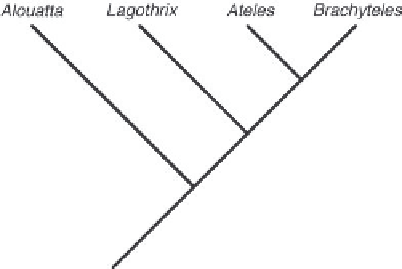Biology Reference
In-Depth Information
Figure 7.9
Cladogram of the living ateline primates, following Rosenberger and Strier
(1989).
(Rosenberger and Strier, 1989). The living ateline genera include
Ateles
(the spider monkey),
Alouatta
(the howler monkey),
Lagothrix
(the
woolly monkey), and
Brachyteles
(the muriqui or woolly spider mon-
key). A widely accepted hypothesis of their genealogical relationships
is shown in
Figure 7.9
.
Despite their close phylogenetic relationships,
the atelines exhibit remarkable diversity in their anatomy, diet, and
behavior (Rosenberger and Strier, 1989). One of the most distinctive
aspects of their anatomical diversity is skull form. Six landmarks were
on the facial skeletons of samples for each genus, and their mean forms
and variance-covariance matrices were estimated. We then scaled each
mean form according to the geometric mean of all distances, so that we
could compare facial
shapes
. The dissimilarity metric described above
(see also Richtsmeier et al., 1998) was used as the basis of hierarchical
cluster analysis using the UPGMA criterion. The empirical clustering
is shown in
Figure 7.10a
.
Note that it is slightly different from
Rosenberger and Strier's (1989) cladogram (
Figures 7.9
and
7.10b
)
.
While both trees are similar in showing that
Alouatta's
shape is most
distinct, the internal structure of the
Lagothrix-Ateles-Brachyteles
cluster differs. While
Ateles
and
Brachyteles
are the most closely relat-
ed,
Ateles
and
Lagothrix
have the most similar shapes. When bootstrap
probabilities (based on 500 resamples) are attached to both the empir-
ical phenogram (
Figure 7.10a
)
and the cladogram (
Figure 7.10b
)
, we
see that the
Lagothrix-Ateles-Brachyteles
cluster is very stable under
resampling. The phylogenetic signal for this part of the tree is very
strong —
Alouatta
is not only the most distantly related, but it is also


Search WWH ::

Custom Search